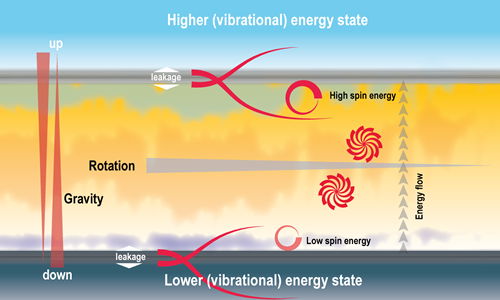

|
Now come the screams of protest.
Physicists will, quite correctly, conclude that if the speed of light is a 'constant' then most of what I have suggested concerning increasing energy states across the spectrum of the universe is probably wrong. And, in so saying their argument would have some force. However, work on this thought for a bit. Perhaps Einstein simply picked the wrong constant in originating his Theory of General Relativity, and in so doing limited his calculations to 'local space-time', not envisaging that space-time across the entire universe might vary. His theory correctly predicted that space is curved in his gravity theory as well as the effect of time dilation in his general theory, but perhaps space only results as as being curved, through physical measurement, because it is curved - spherical or toroidal.
Einstein based his theory on the 'assumption' that the speed of light is constant, and that may have been good enough to make the figures work, complete an equation, and correctly predict time dilation and general local atomic affects but what if, instead of making light speed the constant, he had made 'time' the constant, and calculated in that base energy levels increased across the bandwidth of the universe from the low to the high frequency?
The effect would be that from the low to the high energy boundaries of the universe, the rotational energy and spin rate of atoms would increase. This increase in rotational speed (from lower to higher spin) as increased motive energy is supplied by the higher energy universe, would move the atom to a higher energy state. If an atom's local spin rate was induced into a higher or lower vibrational state that would put it out of sync with the local space time spin rate. The atom would seek to balance itself in space-time and, therefore, its position in the universe. It would move.
So, was Einstein stupid to assume 'light speed' to be a constant?
No, I don't believe he was. Think about this. What if light-speed, by observation and measurement, was always constant 'relative' to the 'local' space-time. It would be a very easy assumption to make. What, however, if the speed of light actually increased or decreased as you moved through, realms of higher or lower energy spin?
Using the model of the simple spinning disc, as the atom moved towards the lower energy part of the universe
it would lose energy and its rotational speed would decrease. Conversely, as it moved towards the higher energy regions its spin, thereby its energy, would increase. This increase or decrease would be relative to changes in its energy state, or energy density, which would be a direct result of its physical position in space-time. Were it in stationary position, but a patch of space-time around it were to change in energy density, the effect would be a local variance in both the light speed and local gravity constants against the fixed constant of time. Only at a 'Lagrange' point in the universe would either of these figures remain fixed, but since the universe is energy fluid, this place is unlikely to exist.
Is there any evidence to support this hypothesis?
Surprisingly, the answer is yes but, as light-heartedly pointed out by Rupert Sheldrake, constantly covered up so that mathematical equations and practical measurement can always be made to agree. In other words, the experimental results are regularly 'fudged' by moving the error bars so that the equation still works despite, on occasions, being significantly at odds with actual physical measurement. Sheldrake points this out in his book, The Science Delusion. The gravity and light-speed constants, when measured over 'time', appear to have moved around quite a bit over the decades since records and the establishment of international standard values began.

My vision for this trends towards the energy density in the universe, and therefore space-time energy values, as in any fluid, being patchy. Perhaps from time to time as our planet passes through regions in local space where the space-time energy may be higher or lower. With time being a constant, instead of light speed, it would explain why there is a variance in the value of the constants, when measured over time.
The universe described in terms of the humble sandwich.
In the diagram above I seek to illustrate how the whole mechanism works, in that it consists of a sandwich with our universe as the filling. The lower slice is vibrating at a lower frequency than the upper slice. This vibration causes energy from both slices to be thrown into the filling in between, which is rotating.
For the atoms in the filling, the rotational force imparts two properties, namely direction of movement and spin. The top slice, since it is vibrating much faster than the lower slice is throwing more energy into the filling than the lower slice, as well as throwing them in with much greater velocity which gives the atoms nearer the top slice a much faster spin-rate or kinetic energy. Likewise, a lower quantity of atoms being energised by the lower slice have less spin energy.
As the atoms, having differing energy states, start to interact with each other as particles in the filling, they need to balance their energy levels and they do this by swapping energy with each other. This exchange of energy produces in some cases, very violent reactions, but eventually the imbalances begin to balance out. This balance point is held in place by gravity in the form of new elements which now, by coming together, have acquired greater 'mass'.
The difference in the vibrational energy between the top slice and the bottom slice provides an energy bias (as it does with centrifugal force) that we experience as gravity. The greater the mass of an object, the greater bias it exerts between the two energy slices.
|
monoatomics |



